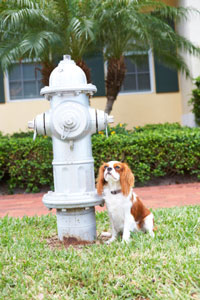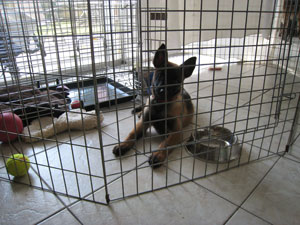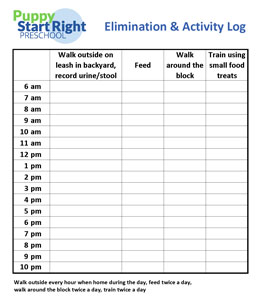Originally Published 1/4/2013
Priority #1
House training might be the most important behavior to teach a new puppy that will live indoors. Few dog owners will tolerate a healthy adolescent or adult canine that lives indoors and urinates or defecates indiscriminately in the home.
Not being house trained is a common behavioral reason that dogs are relinquished to shelters. Other behavioral reasons for inappropriate elimination include separation anxiety, urine marking, submissive urination, or excitement urination. These reasons are not related directly to learning, but to anxiety, fear, or emotional arousal. This article will focus on house training related to lack of training. As the most prevalent location where house training occurs is outside, the focus will be on this location specifically. However, the same methods can be used for any designated elimination location (pee pads, dog litter box, etc).

Encourage instincts and a preferred location
Once they are mobile, puppies naturally leave the "nest" to eliminate away from their resting area. A puppy will seek a location that is porous (absorbent) and away from his eating or sleeping locations. To a puppy, a rug or bath mat may meet the criteria for an appropriate elimination location. Puppy parents need to teach the puppy the preferred place to eliminate.
Though not inherently difficult, house training a healthy puppy successfully requires consistency, predictability, and patience from the caretaker. Patience is key! Like a parent potty training a young child (going from diapers to using the toilet), teaching a dog an appropriate location for elimination does not occur overnight. Accidents are bound to happen, even with diligent supervision. Progress should be seen in house training by 4-6 months of age, yet some dogs may take 9-12 months to be completely house trained.
Positive steps to house training
It is important that the learning process be carried out positively. Punishment and reprimands have no place in house training, as they will only teach the puppy that it is not safe to eliminate in front of people. In fact, punishment might teach a puppy to sneak off to eliminate, making teaching the puppy a human-approved location to eliminate extremely difficult.
There are 5 key steps to successful house training (adapted from Puppy Start Right: Foundation Training for the Companion Dog)
- Prevent accidents from occurring
- Reward elimination in appropriate areas
- Anticipate when a puppy needs to eliminate
- Know what to do when accidents happen
- Clean soiled areas
Prevent accidents from occurring

Close supervision and management are crucial. Set up the puppy for success by controlling the puppy's learning history so that urination and defecation are more likely to occur in a preferred location. Most puppies have an inherent desire for cleanliness and do not eliminate in locations where they sleep or eat. This can be used as an advantage for management and prevention of accidents.
Three management techniques can be helpful: using a crate, using an exercise pen, and the umbilical method. Ideally, all three methods should be incorporated into house training a young puppy.
A crate can make elimination training much easier by providing a safe location for the puppy to be while the owner is otherwise occupied. Rest time and feeding can occur in the crate, and, when properly acclimated to a crate, most puppies find it a comforting place. For house training purposes, the crate should be large enough for the puppy to stand up, turn around, lie down, and stretch out comfortably. If the crate is too large, the puppy might sleep in one area and use another corner for elimination. Once the puppy is house trained, the larger the crate the better.
Another option is to use an exercise pen and enclose a small area for the puppy. The exercise pen will likely be larger than the crate area and can be used for short periods. Just remember that if the area is too large, the puppy is likely to find an elimination spot.
The umbilical cord method is a great way to both enjoy having the puppy with you and keep an eye on him. This method involves keeping the puppy on a leash attached to you as you move about the house. Having the puppy close means that you are more likely to notice when the puppy starts to show subtle signs of impending elimination (sniffing the ground, circling, pulling to move away).
Reward elimination in appropriate areas
Maintain a routine for taking the puppy outside. Use a keyword or phrase, such as "Outside" or "Do you have to go outside?" Always use the same exit and take the puppy outside on leash even if you have a fenced-in yard. Go to a designated elimination area in the yard (one that is full of odors from previous eliminations) and "be boring" (ignore the puppy).
Wait for up to 5 minutes. If the puppy eliminates, immediately after he completes the void reward with a small food treat (Bravo! Training Treats work great). Even better, just as the puppy finishes, mark it with a click and then give a treat. Keep your body and hands still while the puppy is eliminating. If you begin to reach for the treat or start talking, the puppy is likely to stop before emptying completely.
The primary goal is for puppies to be rewarded with a food treat just after eliminating in a desirable location. Timing of the reward is important. Too early, and the puppy is likely to not begin, or stop, eliminating in order to get the treat. Too late (when you have returned inside, for example), and the association between eliminating in a desired location and getting a treat is not formed. The importance of using a food reward is to impress upon the puppy that the best place to eliminate is outside. The puppy would be content with using the area rug in the house. Either location would meet the puppy's criteria for an appropriate elimination location, but the treat comes after eliminating outside.
After receiving the treat for elimination, the puppy can be given some off-leash play time with you if you are in a securely fenced area. Play and attention follow elimination. This additional lesson helps teach a puppy to go outside and "do his or her business" so the fun can begin.
If after 5 minutes of waiting the puppy has not eliminated, return inside and supervise (umbilical cord method) or manage (crate or exercise pen). Try again in 10-15 minutes.
Anticipate when your puppy needs to eliminate

Physically, urinary and bowel sphincter control, or the ability to hold it, takes several months to develop, even up to 16 weeks of age. This means that the once the bladder or colon is full, the puppy cannot wait to go if the muscles are not developed enough physically to prevent elimination. A general rule for how long a puppy can go between elimination opportunities (in hours) is 1 + the puppy's age in months. For example, a 3-month-old puppy might be able to hold it for 4 hours. When active, puppies might have to eliminate more often.
Puppies often have to eliminate after stopping one behavior and starting another. After waking up, playing, and eating are all good times to provide an opportunity to eliminate. Set up the puppy to succeed by anticipating when he will need to eliminate. Be proactive rather than reactive. Initially, you might take the puppy outside 10-15 times in a day and he eliminates only 5 or 6 times. By providing frequent opportunities, you will be more likely to have him in the desired elimination location when he needs to eliminate, thus providing opportunity for reinforcement.
Watch for subtle signs of impeding elimination: suddenly stopping what he is doing, sniffing the ground, circling, or wandering toward the door.
Keep a written log of activity and eliminations. With a set routine for meals, training, play, walks, and elimination opportunities, a pattern of elimination frequency will develop. Keeping a log documents improvement and also identifies problem areas in the house training (the puppy continues to have accidents between 3:00-4:30 p.m. when the kids arrive home from school, for example).
Feeding a highly digestible diet consistently and at set times 2 to 3 times a day will help determine a defecation pattern. Provide a 20-minute window of opportunity for the puppy to eat; any leftover food should be removed once the puppy has walked away from the bowl.
Water should be freely available. Restricting water intake could result in a puppy that ingests a large volume at one time. The consequence of that might be excessive and frequent urination.
Know what to do when accidents happen
If your puppy starts to have an accident in front of you, cue "Outside." This might delay the elimination for the few moments you need to get him outside. Reward elimination in the appropriate location.
Verbally reprimanding or physically punishing a puppy for eliminating in front of you will only teach him it is unsafe to eliminate in front of people. The puppy will sneak off to go, where it is "safe." If a puppy is reluctant to eliminate in front of people, then it is difficult to reward him for eliminating in the desired location.
If you find an accident after the fact, just clean it up and review your supervision and management strategies.
Clean soiled areas
Because dogs are drawn to spots where previous elimination has occurred, thorough cleaning of the area is imperative. Avoid any products containing ammonia, vinegar, or bleach because these smells can act as an attractant.
Soak up or pick up as much of the accident as possible. Apply an enzymatic cleaner and allow it to dry on the area for 24 hours.
Once the area is dry, apply a scent to deter future elimination in that area. Citrus and pine scents are good options. However, the option found to be the most effective is the slight scent of mothballs. To lay down the scent, either wipe the mothball directly on the area to leave a residual scent or powderize the mothball (place in two sealed bags and crush outside) and apply 1/8 of a teaspoon deep into the pile of the carpet or fabric. Any residual powder should be removed. You should not be able to smell the mothball when you enter the room, but only if you smell the exact location where it was applied (and there it should just be the hint of the odor).
Caution: Mothball crystals are toxic if consumed by dogs or people. Do not use mothballs on bedding, in areas where a puppy is confined, or on objects that may be chewed or ingested.
Success!
With these guidelines and consistent, positive training most puppies can be house trained successfully. Lack of success with house training or regression in house training may indicate a medical problem that should be evaluated by a veterinarian. Vaginitis and urinary tract infections are common in young and adolescent dogs.
With a healthy dog, one that is set up for success and positive reinforcement, house training will be among the earliest behaviors where you and your dog find success together. With an elimination routine in place, everyone in the family can enjoy home sweet home.
Related Products
|
|
|





Post new comment